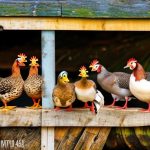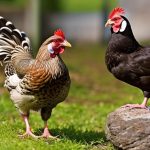When a dog exhibits aggressive behavior towards chickens, it is essential to identify the underlying causes to address the issue effectively. Dogs are inherently predatory animals, and their instinct to chase and hunt can be triggered by the movement and presence of chickens. This behavior is deeply rooted in their genetic makeup and can be challenging to eliminate entirely through training.
Furthermore, insufficient socialization with chickens during a dog’s early developmental stages can contribute to aggressive tendencies towards them. Recognizing these fundamental factors is crucial in developing strategies to promote peaceful coexistence between dogs and chickens. Individual dog personalities and temperaments also play a significant role in their behavior towards chickens.
Some dogs possess a stronger prey drive than others, making it more difficult to train them to interact peacefully with chickens. Additionally, fear or anxiety may contribute to a dog’s aggressive behavior towards chickens. By thoroughly understanding the root causes of the problem, pet owners can implement targeted approaches to address the issue and create a safe environment for both dogs and chickens.
Table of Contents
- 1 Creating a safe and secure environment for both the dog and the chickens
- 2 Training the dog to coexist peacefully with the chickens
- 3 Using positive reinforcement to discourage aggressive behavior
- 4 Supervising interactions between the dog and the chickens
- 5 Seeking professional help if the problem persists
- 6 Implementing preventative measures to avoid future attacks
- 7 FAQs
- 7.1 What are some methods to keep a dog from attacking chickens?
- 7.2 How can training and socialization help prevent a dog from attacking chickens?
- 7.3 What types of physical barriers can be used to prevent a dog from attacking chickens?
- 7.4 What are some distractions or deterrents that can be used to keep a dog from attacking chickens?
- 7.5 Are there any specific breeds of dogs that are more prone to attacking chickens?
Key Takeaways
- Understanding the root of the problem: Identify the reasons behind the dog’s aggressive behavior towards the chickens, such as prey drive or lack of socialization.
- Creating a safe and secure environment for both the dog and the chickens: Provide separate living spaces and secure enclosures to prevent any potential harm to the chickens.
- Training the dog to coexist peacefully with the chickens: Use positive reinforcement techniques to teach the dog to ignore, respect, and coexist with the chickens.
- Using positive reinforcement to discourage aggressive behavior: Reward the dog for calm and non-aggressive behavior around the chickens to reinforce positive interactions.
- Supervising interactions between the dog and the chickens: Always closely monitor and supervise any interactions between the dog and the chickens to prevent any potential harm.
Creating a safe and secure environment for both the dog and the chickens
Separate Living Spaces
One of the primary steps in achieving this is to provide separate living spaces for the dog and the chickens. This can be done by installing a secure coop for the chickens that is inaccessible to the dog, such as a fenced-in area with a roof or a predator-proof coop.
Addressing the Dog’s Needs
Additionally, providing the dog with a designated area in the yard or home where they can be safely contained when unsupervised can help prevent any potential confrontations. It’s also essential to consider the dog’s physical and mental stimulation. Ensuring that the dog receives regular exercise, mental enrichment, and attention can help reduce their predatory instincts and redirect their focus away from the chickens.
Positive Reinforcement and Training
Providing toys, interactive games, and training activities can help keep the dog mentally engaged and less likely to fixate on the chickens. Furthermore, providing positive reinforcement for calm and non-aggressive behavior around the chickens can help create a positive association with their presence. By providing separate living spaces, addressing the dog’s physical and mental stimulation, and using positive reinforcement, pet owners can help minimize the risk of aggressive behavior and create a harmonious environment for both pets.
Training the dog to coexist peacefully with the chickens

Training the dog to coexist peacefully with the chickens requires patience, consistency, and positive reinforcement. One of the first steps in this process is desensitizing the dog to the presence of the chickens. This can be done by gradually introducing the dog to the chickens from a distance while providing positive reinforcement for calm and non-aggressive behavior.
Over time, the distance between the dog and the chickens can be decreased as long as the dog remains calm and non-reactive. Additionally, teaching the dog basic obedience commands such as “leave it,” “stay,” and “come” can be instrumental in managing their behavior around the chickens. These commands can be used to redirect the dog’s attention away from the chickens and reinforce positive behavior.
Consistent training sessions and regular practice in a controlled environment can help solidify these commands and improve the dog’s impulse control around the chickens. It’s also important to monitor the dog’s body language and behavior around the chickens. Signs of arousal or fixation should be addressed immediately by redirecting the dog’s attention or removing them from the situation if necessary.
By consistently training and reinforcing positive behavior, pet owners can help their dog learn to coexist peacefully with the chickens.
Using positive reinforcement to discourage aggressive behavior
Using positive reinforcement is an effective way to discourage aggressive behavior in dogs towards chickens. Positive reinforcement involves rewarding desired behaviors with treats, praise, or toys, which helps to strengthen those behaviors over time. When it comes to addressing aggressive behavior towards chickens, positive reinforcement can be used to create a positive association with their presence and encourage calm and non-reactive behavior.
For example, when the dog remains calm and non-aggressive around the chickens, they can be rewarded with treats or praise. This helps to reinforce their calm behavior and creates a positive association with being around the chickens. Consistency is key when using positive reinforcement, as it helps to solidify the desired behavior and encourages the dog to continue exhibiting it.
It’s important to note that punishment or aversive training methods should be avoided when addressing aggressive behavior towards chickens. These methods can create fear, anxiety, or aggression in dogs, which can exacerbate the problem rather than resolve it. By using positive reinforcement, pet owners can effectively discourage aggressive behavior in their dogs towards chickens while creating a harmonious environment for both pets.
Supervising interactions between the dog and the chickens
Supervising interactions between the dog and the chickens is crucial in ensuring their safety and well-being. Even after training and positive reinforcement, it’s important to closely monitor their interactions to prevent any potential confrontations. This can be done by keeping the dog on a leash or using barriers to control their access to the chickens during supervised interactions.
Additionally, observing the dog’s body language and behavior around the chickens can provide valuable insight into their state of mind. Signs of arousal, fixation, or predatory behavior should be addressed immediately by redirecting the dog’s attention or removing them from the situation if necessary. By closely supervising their interactions, pet owners can intervene proactively to prevent any potential conflicts.
It’s also important to gradually increase the duration of supervised interactions over time as trust and positive behavior are established. This allows for gradual exposure and acclimation while maintaining a safe and controlled environment for both pets. By consistently supervising interactions between the dog and the chickens, pet owners can help ensure their safety and promote peaceful coexistence.
Seeking professional help if the problem persists

Expert Guidance and Support
A professional dog trainer or animal behaviorist with experience in working with predatory behavior can provide valuable insight and guidance in addressing this issue. They can assess the situation, develop a customized training plan, and provide ongoing support to help modify the dog’s behavior.
Ruling Out Underlying Issues
Seeking professional help can also help rule out any underlying medical or behavioral issues that may be contributing to the problem. A thorough evaluation by a veterinarian or animal behaviorist can help identify any potential physical or psychological factors that need to be addressed in order to resolve the issue.
Recognizing the Need for Professional Assistance
It’s important for pet owners to recognize when they may need professional assistance in addressing aggressive behavior towards chickens. Seeking professional help can provide valuable support and expertise in developing an effective plan to help the dog coexist peacefully with the chickens.
Implementing preventative measures to avoid future attacks
Implementing preventative measures is essential in avoiding future attacks and ensuring the safety of both the dog and the chickens. This can include reinforcing secure enclosures for both pets, such as predator-proof coops for the chickens and designated areas for the dog when unsupervised. Additionally, providing regular exercise, mental enrichment, and attention for the dog can help reduce their predatory instincts and redirect their focus away from the chickens.
Consistent training and positive reinforcement should also be maintained to reinforce calm and non-aggressive behavior around the chickens. This helps to create a positive association with their presence and encourages peaceful coexistence over time. It’s also important to consider ongoing supervision of interactions between the dog and the chickens, especially during times of heightened arousal or excitement.
By implementing preventative measures, pet owners can help minimize the risk of future attacks and create a safe and harmonious environment for both pets. In conclusion, addressing aggressive behavior in dogs towards chickens requires understanding the root of the problem, creating a safe environment for both pets, training with positive reinforcement, supervising interactions, seeking professional help if needed, and implementing preventative measures. By taking a targeted approach that addresses these key areas, pet owners can help their dogs coexist peacefully with chickens while ensuring their safety and well-being.
If you’re looking for tips on how to keep your dog from attacking your chickens, you may also be interested in learning about the best flooring options for your chicken coop. Check out this article on choosing the right flooring for your chicken coop to ensure the safety and comfort of your feathered friends.
FAQs
What are some methods to keep a dog from attacking chickens?
Some methods to keep a dog from attacking chickens include proper training and socialization, using physical barriers such as fences or kennels, and providing distractions or deterrents such as toys or noise-making devices.
Training and socialization can help a dog understand appropriate behavior around chickens and other animals. Positive reinforcement training can teach a dog to ignore or leave chickens alone, while socialization can help a dog become accustomed to the presence of chickens without feeling the need to chase or attack them.
What types of physical barriers can be used to prevent a dog from attacking chickens?
Physical barriers such as fences, kennels, or chicken coops can be used to separate dogs from chickens. These barriers can help keep the two animals apart and prevent any potential attacks.
What are some distractions or deterrents that can be used to keep a dog from attacking chickens?
Distractions such as toys or interactive feeders can help redirect a dog’s attention away from the chickens. Additionally, noise-making devices or motion-activated sprinklers can serve as deterrents to discourage a dog from approaching or attacking chickens.
Are there any specific breeds of dogs that are more prone to attacking chickens?
Some breeds of dogs, such as terriers or hunting breeds, may have a higher prey drive and be more prone to chasing or attacking chickens. However, any dog can potentially exhibit this behavior, so it is important to address it through training and management regardless of the breed.
Meet Walter, the feathered-friend fanatic of Florida! Nestled in the sunshine state, Walter struts through life with his feathered companions, clucking his way to happiness. With a coop that’s fancier than a five-star hotel, he’s the Don Juan of the chicken world. When he’s not teaching his hens to do the cha-cha, you’ll find him in a heated debate with his prized rooster, Sir Clucks-a-Lot. Walter’s poultry passion is no yolk; he’s the sunny-side-up guy you never knew you needed in your flock of friends!







